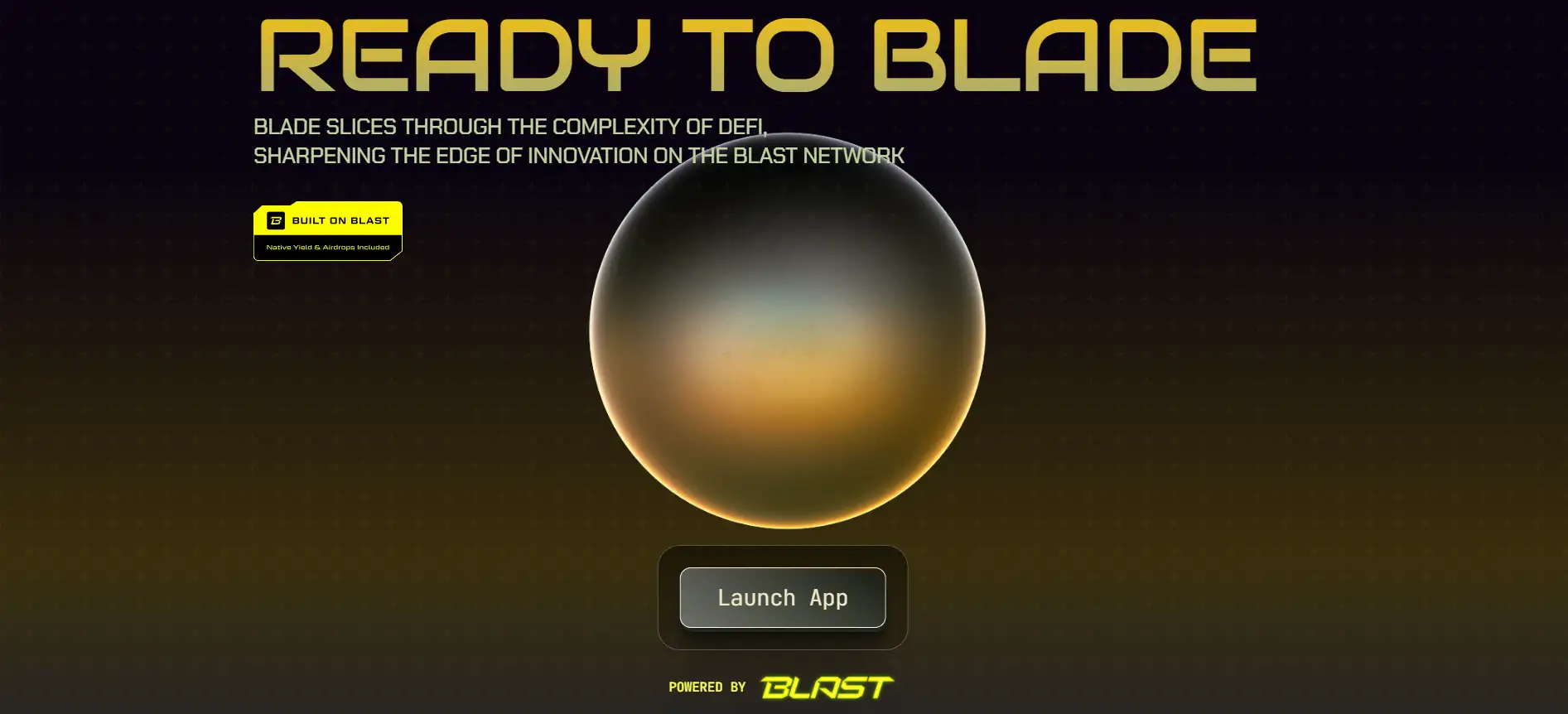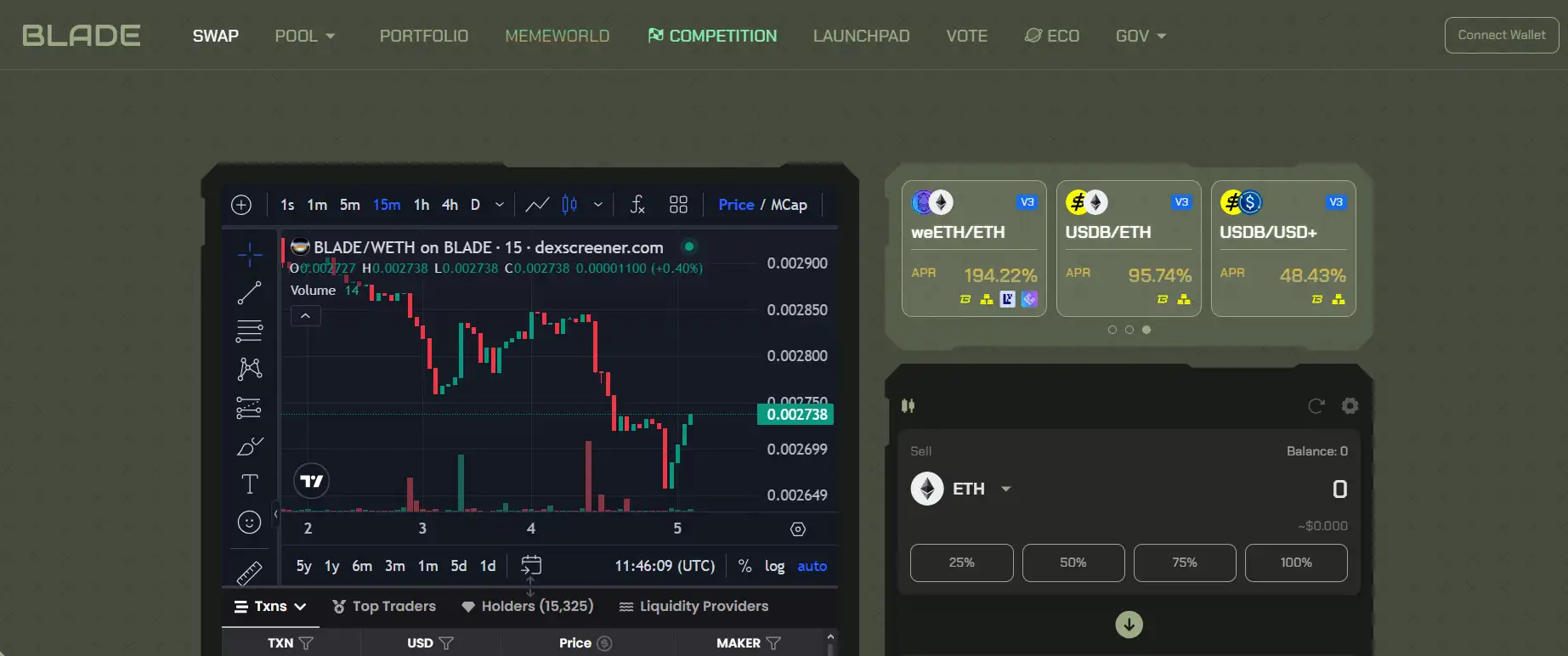About BladeSwap
Blast is an innovative Layer 2 (L2) solution built to address key inefficiencies within the Ethereum ecosystem, particularly the lack of native yield generation for assets such as ETH and stablecoins. This pioneering platform provides an EVM-compatible optimistic rollup architecture that integrates seamlessly with existing Ethereum-based applications, ensuring a familiar user experience while offering enhanced financial benefits. Unlike traditional Layer 2 platforms that fail to generate yield for bridged assets, Blast enables users to earn yields of approximately 4% for ETH and 5% for stablecoins like USDB, effectively countering inflation and enhancing the utility of their assets.
Blast’s unique approach is centered around leveraging advanced DeFi protocols, such as Lido for ETH staking and MakerDAO’s on-chain T-Bill protocol for stablecoin yields. The platform ensures these benefits are automatically reflected in user balances through its auto-rebasing mechanism, providing a seamless, hands-off yield accumulation experience. Additionally, Blast’s groundbreaking gas revenue-sharing model empowers developers by redistributing net gas revenue to subsidize user gas fees or fund their projects, fostering a more equitable and developer-friendly ecosystem. With substantial backing from top-tier investors such as Paradigm and Standard Crypto, Blast is positioned as a transformative force in the Layer 2 landscape, offering a sustainable and rewarding experience for both users and developers.
Blast emerged as a visionary solution to address critical inefficiencies in existing Ethereum Layer 2 (L2) platforms. The lack of yield generation for bridged assets has long been a pain point for users and developers alike, with traditional L2 solutions offering 0% interest rates on ETH and stablecoins. This limitation leads to inevitable asset depreciation over time, particularly in an inflationary environment. To address these issues, the creators of Blur, a renowned NFT marketplace, introduced Blast as an advanced EVM-compatible optimistic rollup designed to redefine the Layer 2 ecosystem.
One of Blast’s defining features is its ability to generate native yields on bridged assets. For ETH, the platform integrates with leading DeFi staking protocols, such as Lido, to offer users an approximate 4% yield. For stablecoins, users bridge their assets in exchange for USDB, a Blast-native stablecoin that provides around a 5% yield via MakerDAO’s on-chain T-Bill protocol. These yields are delivered directly to users through the platform’s innovative auto-rebasing mechanism, which ensures asset balances grow automatically without requiring manual intervention or staking strategies.
Beyond yield generation, Blast introduces a first-of-its-kind gas revenue-sharing model that sets it apart from competitors such as Arbitrum and Optimism. Instead of retaining gas fee revenue, Blast redistributes it to developers programmatically, providing financial incentives for building on the platform. This innovative feature allows developers to either retain revenue or subsidize gas fees for their users, fostering an attractive and cost-effective ecosystem.
Since its launch, Blast has secured significant investment, raising $20 million from prominent backers, including Paradigm and Standard Crypto. It has also demonstrated its commitment to community engagement through initiatives such as the Blast Community Airdrop, which incentivizes both users and developers to participate in the ecosystem. These strategic moves have positioned Blast as a leader in the Layer 2 space, delivering unique benefits that address long-standing challenges in the industry.
By combining native yield generation, auto-rebasing mechanisms, and a developer-centric revenue-sharing model, Blast offers unparalleled advantages over its competitors. Its seamless integration with Ethereum-based applications ensures ease of adoption for developers and users alike.
Blast brings a host of transformative benefits and features that redefine the Layer 2 experience:
- Native Yield Generation: Blast enables users to earn automatic yields of approximately 4% for ETH and 5% for stablecoins, addressing the zero-yield limitation of other L2 solutions. Learn more at https://blast.io/en/bridge/.
- Auto-Rebasing Mechanism: User balances adjust automatically to reflect accrued yields, simplifying asset management and eliminating the need for manual staking or reinvestment strategies.
- Gas Revenue Sharing: Blast redistributes net gas revenue to developers, empowering them to subsidize user gas fees or fund DApp development, creating a more sustainable and user-friendly environment.
- EVM Compatibility: As an EVM-compatible optimistic rollup, Blast allows for seamless integration with existing Ethereum applications, ensuring minimal disruption for developers and users.
- Community Engagement: Blast actively incentivizes user and developer participation through initiatives like the Blast Community Airdrop, fostering a vibrant and growing ecosystem.
Getting started with Blast is a simple and rewarding process. Follow the steps below to begin:
- Visit the Official Website: Head to https://blast.io/en/bridge/ to access the Blast platform.
- Connect Your Wallet: Click the "Connect Wallet" button and select a compatible Ethereum wallet such as MetaMask to securely link your account.
- Bridge Your Assets: Choose the asset you wish to bridge (e.g., ETH or supported stablecoins) and confirm the transaction through your wallet interface.
- Earn Yields Instantly: Once bridged, your assets automatically start accruing yields. You can monitor your growing balance directly in your wallet.
- Explore the Ecosystem: With assets on Blast, access and interact with a wide range of DApps and benefit from lower transaction costs and enhanced functionalities.
- Engage with the Community: Earn Blast Points by participating in the ecosystem and enjoy rewards through community-driven initiatives.
BladeSwap FAQ
Blast generates yields by integrating with advanced DeFi protocols. For ETH, it leverages staking platforms such as Lido to provide an estimated 4% yield. For stablecoins, it uses MakerDAO’s on-chain T-Bill protocol to generate around a 5% yield. These yields are automatically reflected in your balances via the auto-rebasing mechanism, so users earn passively without the need for manual staking or farming. To learn more, visit the official page: https://blast.io/en/about/.
The gas revenue-sharing feature of Blast redistributes net gas revenue directly to developers who build on the platform. This empowers developers to either retain the revenue as a profit or use it to subsidize gas fees for their users. This model not only incentivizes development but also creates a more affordable ecosystem for users. For details, visit https://blast.io/en/bridge/.
Yes, Blast automates the yield generation process completely. Once you bridge your assets to Blast, the platform automatically accrues yields through its integrations with protocols like Lido and MakerDAO. The balances in your wallet adjust automatically via an auto-rebasing mechanism, so there’s no need for manual staking, interacting with liquidity pools, or worrying about transaction complexities. To start earning, visit https://blast.io/en/bridge/.
The Blast Community Airdrop is divided into rewards for Early Access Members and Developers. Users earn Blast Points by bridging their assets, and these points can be redeemed in future airdrop events. Developers are incentivized through grants and additional rewards for building impactful DApps on the platform. This program ensures community participation and promotes a thriving ecosystem. Learn more at https://blast.io/en/about/.
The auto-rebasing mechanism on Blast automatically adjusts your wallet balances to reflect accrued yields. For instance, if you bridge ETH to Blast, your wallet balance grows daily based on the approximate 4% yield derived from staking. Similarly, stablecoin balances adjust based on the 5% yield provided by MakerDAO’s on-chain T-Bill protocol. This ensures you always see an updated balance without having to claim or reinvest manually. For more details, visit https://blast.io/en/bridge/.
You Might Also Like












